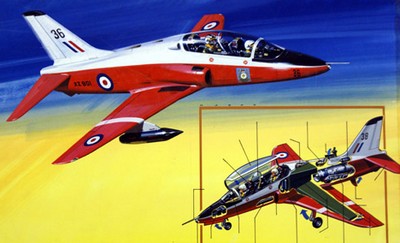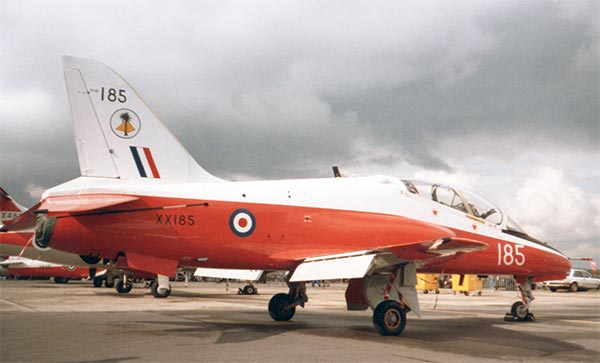a series of 1/72 kits
1/72 scale kits of the Hawker Siddeley/BAe Hawk jet trainer
 ..............
..............
The Hawk was developed by Hawker Siddeley in the UK as an advanced jet trainer for the Royal Air Force. It was to replace the Folland Gnat and a small not too expensive single Adour engined trainer was envisaged. The Hawk prototype flew in August 1974. It has a two man cockpit with the instructor in the rear higher set seat, with Martin Baker Mk.10B ejection seats. It is capable of high speed training with MACH 0.9 cruising capability and MACH 1.1 in a dive at high G-loads. The first early generation Hawk for the RAF was the T.1 and the first aircraft was delivered at the end of 1976. The famous Red Arrows aerobatic display team got their Hawks end 1979.

photo made at Fairford
The Hawk was also purchased for the British Royal Navy, where they replaced Canberra's. These few Hawks are used to train ship in air defense.
Finland also bought some 50 Hawk mk.51 aircraft in 1980 and made under license at Valtion lentokonetehdas. They were officially designated as trainers but were also capable for strike missions. The demoteam Midnight Hawks used the type. (Later additional aircraft were purchased, including 18 second hand planes from Switzerland in 2009. Several system upgrades were done including a glass cockpit as Mk.51 and Mk.66 ).
Also for export the Hawk proved to be popular as versions were developed that were capable of a light strike mission and even air defense with Sidewinder missiles in a low cost solution. Variations in equipment and engines were possible. A central 300 mm Aden gun pod could be fitted under the fuselage and various pylons for armament.
Later a big
company was formed that including Hawker Siddeley under British Aerospace
(BAe).
In those days
another country that bought Hawks was Kenya for 12 aircraft. Another export
country was Indonesia, and more than 40 Hawk deliveries starting in the
eighties.
A big customer was Saudi Arabia that purchased in the mid eigthies over 50 Hawks Mk.65 in order to enable training for their Tornado aircraft pilots. Later on additional aircraft were ordered.
Zimbabwe (former Rhodesia) bought 8 Hawks Mk.60 in the early eighties.
The later production Hawks manufactured got also some modifications. The RAF aircraft were modified in 1983 to 1986 to T1A to even fire Sidewinder air-to-air missiles. Under the rudder, the fillet is longer and the rear upper fuselage shape a bit flatter above the tail pipe. The wind shield bird strike protection was also improved with thicker shield that also sticks out a bit at the lower forward edge. The Martin Baker seats were also of a later model.
For the Swiss Air Force, 20 Mk.66 Hawks were ordered end of the eighties and most of them assembled at Emmen until 1991. (later on, 18 went to Finland).
Zimbabwe bought an additional 5 Mk.60A Hawks in the nineties.
Abu Dhabi, United
Arab Emirates Air Force also got about 16 Mk.60A and 8 Mk.61 aircraft.
Abu Dhabi got 4 Mk.63A planes in 1995.
![]()
We can distinguish
the first generation and later generation with the -100 series Hawk. The
newest generation includes:
Later Hawks in the series 100 had longer noses with camera's etc. They also got system upgrades. So check the peculiar aircraft you want to make.
South Korea got some 12 Hawk Mk.100 (with longer nose) in the beginning of the nineties.
The Hawk was modernized beginning 2004 with a glass cockpit and new systems, becoming the Mk. 128/Hawk T2. Also FLIR systems were fitted in a longer nose and these Hawks were also exported to e.g Australia. Also for the RAF, dozens of existing Hawks were refurbished and modernized with re-enforced fuselages to T2 standard around 2010-2012. The wind shield is thicker for bird strike protection that also sticks out a bit at the lower forward edge.
The later production series had again under the rudder a longer fillet and the upper rear fuselage shape is more "flatter" above the jet pipe. The more powerful Adour engine types are 681, 871 or 951.
India purchased starting in 2008 over 100 Hawks mk.132 for their Air Force and Navy at various stages, including license manufacturing by Hindustan Aeronautics Limited.
Local license production of the Hawk was started in South Africa as well beginning 2005 with 24 aircraft ordered by the SAAF.
The Hawk series Mk.100's was modernized even more and systems capabilities ugraded, like forward looking infrared in the nose, a redesigned wing with tip launchers possible. In the cockpit a HOTAS system and the Martin Baker mk. 10L seats are of an improved model. The vane sitting on top of each flap is now full flap wide (whereas first generation Hawk had a vane of about 80% flap wide). Optional is a brake parachute, that is fitted in a prominent tail fairing.
Orders were obtained from Abu Dhabi, Oman, Malaysia, Indonesian, Bahrain and later on also for Canada, known as the CT-155 Hawk.
The series of Mk.120's feature new structural parts and is in fact a whole new aircraft.
Australia bought over 30 Hawks Mk.127, deliveries starting around 1998. Also Saudi Arabia and Oman bought these Hawks.
The British RAF and Royal Navy also got Hawks of the new generation, known as the Mk.128.
A special version was the Hawk 200 single-seat version, to be used as a "multirole combat aircraft". It was developed end nineties. Over 60 aircraft were purchased by Indonesia, Malaysia and Oman.
page 1
page 2
page 3
page 4
page 5
page 6
page 7
page 8
page 9
page 10
Many kits have appeared of the Hawk, particularly in 1/72 scale. We can distinguish the first generation and later generation with the -100 series Hawk.
Airfix, Matchbox and Fujimi came with kits in the seventies and eighties and later an Italeri kit (later under the Revell label) was issued as well. (In 1/32 scale, Revell came with a nice Hawk in 2012, whereas in 2013 Kinetic has also issued a 1/32 kit; these are in the 1/32 modelling REPORTS here..... ).
Many, yes many box illustrations appeared during the years... let's have a look at them. (you can go through the pages from 1 to the next page below..)
First generation HAWKS:
(A)
Airfix
kit (03026), old kit
(F)
Fujimi
(R)
Revell
(I)
Italeri: same mould as the Revell kit
(R)
(M)
Matchbox
(PK-27)
(A2) Airfix
(Hornby) with new mould
Later generation Hawks (series 100...):
(I2)
Italeri
next generation Hawk (adapted old mould)
(A3)
Airfix
next gen (Hornby) with new mould
So, as I had a whole pile of old Hawk kits of the First generation... it was time to built them!

In parallel several models will be made, almost straight out of the box but in various colour schemes and various air forces. (also a Seahawk is seen... that's not a Hawk!)
General kit construction notes:
Some comments will be provided at each kit later on.
All Hawks show
drooped rear flaps with a vane when on the ground. The vane of the
flap was NOT full span to give a better stall characteristics.
None of these
kits have these, which is an omission. It was decided to open up and droop
on many Hawk kits made, which is a lot of work.
After 1986, Hawks got a thicker windscreen for better bird strike protection. A very small step is than seen at the front wind screen frame (very small in 1/72).
If you want to make a specific Hawk, either a First generation like a T1, or a later generation "series 100" aircraft, check the shape of the fairing at the rear of the rudder above the jet exhaust. A "short fillet" or "long fillet" can be seen on Hawks. Adapt as desired. Also, the nose shapes vary depending on the variant.
Cockpit colours
usually are matt medium grey, with certain details in black.
Ejection seats
usually matt buff or dark green headrest, parapack and harnesses als buff,
blue or grey. Ejection seat frames are medium grey.
Wheel bay interiors usually light
grey or off white.
Gear legs gloss light aircraft grey.
Inside of gear doors off white or
light grey.
Often, canopy frame has a buff /
off white sealing.
Check photos of the particular Hawk
to be built.
Magazines:
- Scale aircraft modelling, June 2004, with nice drawings
- ModelAid, old drawing
- Air international volume 75, pages 38 - 50 ; volume 15, pages 133-135; volume 56, pages 140; vol 69-no3-p35; vol 36, pages 59-70.
- Flight international nos. 4104, 4453
About T-45 Goshawk: Flight international nos. 4260, 4264, 4296 ; Air international vol 52, pag 20
Books:
- Hawk, Aeroguide , UK
- Ian Allan series, Hawk, modern
combat no 20
- BAE Hawk T1, detail book, Kagero
Topshots 49
- Hawk comes to age, Peter R March,
RAFBFE, 1995
Back to 1/72 Models.......

(c) Copyright Meindert "designer"/ All rights reserved. Your comments are welcomed by webmaster
Created this page
April 12 , 2013